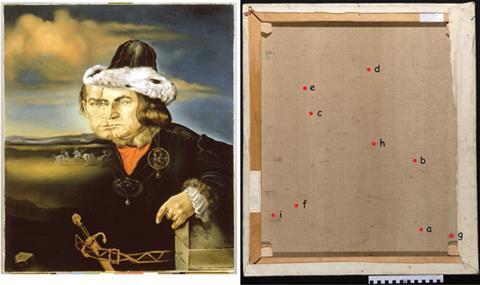A new technique for assessing the condition of works of art without taking samples from them has emerged from a research collaboration between conservators, curators and scientists.
Paintings undergo little mechanical stress hanging in a gallery, but are often transported between exhibitions. It is not easy to assess by eye whether they are strong enough to withstand handling and travel, and taking samples from them is not a desirable option.
The risk of paint degradation is increased if the painting's canvas is in a poor condition, but so far more attention has been given to understanding paint layers than the supports behind them. Reductions in heritage funding make accurate scientific evidence crucial for optimising the environment and handling of paintings.
Traditionally, canvases are made from natural fibres, which vary in resistance to humidity, temperature and acidity. Acid is known to shorten and consequently weaken the polymer chains that constitute the fibres.
Near infrared spectroscopy (NIR) can create a fingerprint of these fibres without even touching them. The fingerprint allows characterisation of the canvas, but used alone gives no useful information about the state of the canvas.
The multidisciplinary team measured the acidity and length of fibres of small reference samples from 19th to 20th century canvases with similar provenances to the paintings of the famous Salvador Dalí. The type of fibre was determined using microscopy and NIR spectroscopy. They then used NIR alone to assess a valuable collection of Dalí paintings from the Gala-Salvador Dalí foundation in Spain, without taking any samples. Using data analysis techniques, they were able to determine acidity, fibre-composition and fibre length of the Dalí paintings by correlating the NIR spectra with the results from the reference samples.

17 conservation experts assessed the same reference samples using a standard stretching technique and assigned each to a category from one (fragile canvas) to four (good condition). Matija Strlic, from University College London in the UK, part of team that developed the method says he was pleasantly surprised by the results considering the subjectivity of this assessment: ‘agreement of condition category data with fibre length data was actually quite extraordinary.’ The category system allowed qualitative assessment to be linked to quantitative chemical analysis making their method easier for conservators to interpret.
Bronwyn Ormsby, a conservation scientist at Tate in the UK, was impressed by the work. ‘One advantage of this type of non-destructive analysis is that the entire canvas can be surveyed.’ Sampling in only a few areas means results may not be representative of the whole object. She thinks, however, that this method may not be of immediate use to many groups as access to NIR equipment and data analysis expertise is currently limited.
It is perhaps befitting that Dalí‘s paintings were subject to this analysis, as his own interest in science is well documented in his paintings. Happily, the majority of his paintings analysed for this study were shown to be in good condition, and can safely continue to be enjoyed.






No comments yet